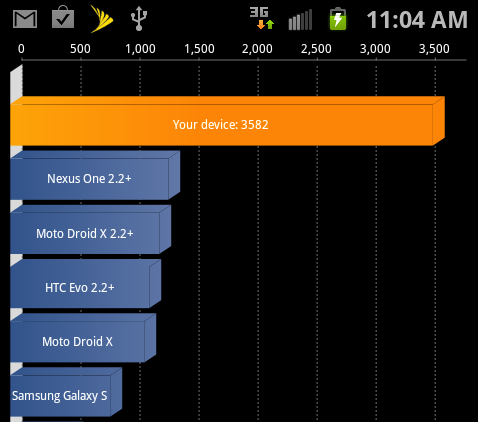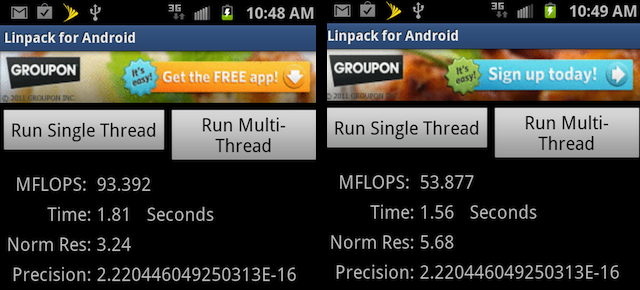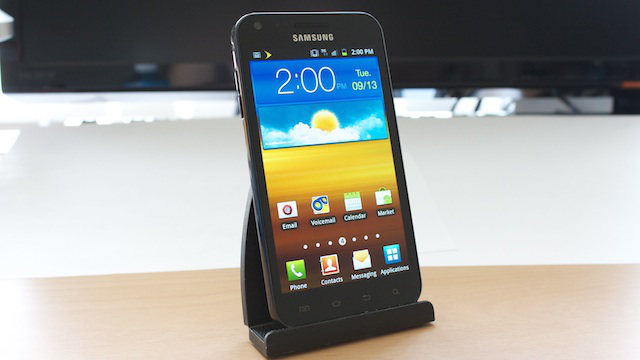Our patience has finally paid off: within the next few days, the Samsung Galaxy S II will finally land in the US on AT&T and Sprint. Since the phone landed in our hands, we’ve enjoyed nearly every minute with it—it’s fast, it’s thin, it’s light, and the screen is enormous. We wouldn’t call it flawless, but we haven’t been this impressed by a phone in a long time.
The Galaxy S II AT&T and Sprint versions are physically different: AT&T’s is slightly thinner and has a 4.3-inch screen, while Sprint’s has a 4.5-inch screen. We received the Sprint version to review, which has “Epic 4G Touch” appended to its name, but we will refer to it as Galaxy S II throughout.
With its 4.5-inch screen, the wide-set Galaxy S II is edging toward feeling like you’re holding a billboard, or trying to fool yourself that your smallish tablet is still a one-handable phone. That’s not to say you can’t still one-thumb type, but my lone thumb can’t stretch all the way to the top of the screen. Haptic feedback is a little tinny, but on the softer side.




The Galaxy S II feels light for its size, and is very thin at 0.38 inches. The back is crosshatched plastic similar to the Samsung Conquer 4G, which feels cheap, but if that’s where manufacturers must skimp to take care of the phone’s performance, we’re willing to overlook it. A silent/sleep button is located on the top right side of the phone, with a volume rocker on the top left side. A micro-USB port is centered on the bottom edge, but the phone lacks the mini-HDMI port found on many higher-end phones lately. The phone is DLNA-capable for HD video streaming, if you have the compatible hardware.
The camera on the Galaxy S II takes good shots, even in low light. Colors in the photos are faithful to reality, and the level of detail in indoor flash-less shots is more than respectable. The camera has tap-to-focus, a feature that we miss when it’s not included, and has only minor shutter lag between shots. The 1080p video the Galaxy S II records looks great, and the auto-focus picks up on subjects a second or so after you target them.

The internals of the Galaxy S II include a 1.2GHz dual-core Cortex A9 processor, 1GB of RAM, and 16GB of storage that can be supplemented by up to a 32GB microSD card. Performance-wise, the Galaxy S II lives up to every bit of reverence it received since its European launch. The Android 2.3.4 Gingerbread operating system is quick, and even intensive apps open nearly instantly. Samsung’s TouchWiz UI overlay can do no harm to the Galaxy S II’s operations, though we take issue with the way the settings menus are arranged in this phone. (“USB utilities” are under the “Wireless and network” menu. That's intuitive.)
The phone’s benchmarks show off its speed, and the US Galaxy S II marks even better than the European one did months ago. A Quadrant score of 3582 burns the Motorola Droid Bionic’s scores down in the 2400 range. In Linpack, the Galaxy S II scores 93.4 MFLOPS in single-threaded processes, and 53.87 MFLOPS in multi-threaded ones, the highest scores we’ve seen recently by a long shot.


The Galaxy S II’s screen is not as stellar the rest of the phone. As a Super AMOLED Plus display, it’s bright enough and renders text much better than the PenTile displays used in many other phones lately, despite its 800x480 resolution. This makes it great for reading on the Web, even on sites that don’t render as mobile versions with the phone’s large default text.
But the screen has a very warm cast to it even at the brightest settings, so whites look yellowish-brown, like you’re looking at the phone through sunglasses. Samsung may have tuned it this way to mitigate the AMOLED’s brightness, but we found it off-putting. This isn’t an obstacle that can’t be overcome, and we’d likely get used to it after a while—some people prefer warmer-toned screens. But every surrounding phone’s screen will always look bluish and undersaturated by comparison.


Related to the screen, the Samsung keyboard that appears on the Galaxy S II is nice to use while in Swype mode, even when typing. More than any phone we’ve used recently, our thumbs can fly. But with Swype turned off (input method set to “Samsung keypad”) the keyboard is janky and much slower for some reason. We’d avoid it unless a software update comes in to fix it.
According to Samsung’s spec sheet, the Galaxy S II has an 1800mAh battery good for up to 8.7 hours of talk time. We were able to get six hours out of the phone while playing video, and found it easy to get a day’s use out of it with light to moderate use (infrequent texting, e-mailing, web browsing, a bit of gaming). 4G can run the battery down faster, but just as often, having to keep the phone on while Sprint’s pokey 3G spins its wheels is just as bad. Still, we found interaction with the 3G network better than on the last two Sprint phones we reviewed (Samsung Conquer 4G and Motorola Photon 4G).

While the Galaxy S II is an ideal phone, the greatest drawback for many would-be customers may end up being that there are no plans for the phone to be available on Verizon. Current speculation suggests that Verizon is due to get the Nexus Prime in the next couple of months, so those who don’t want to switch carriers may want to hold out for that. If you’re carrier-agnostic, you may want to wait to see how the T-Mobile Galaxy S II shapes up: the company has announced that their version will have a beefier 1.5GHz dual-core processor, though it still has no release date.
That aside, we are deeply impressed with the Galaxy S II, even on Sprint’s network, and especially for $199.99 with a two-year contract. No phone is perfect, but the Galaxy S II comes the closest we’ve seen.
reader comments
107